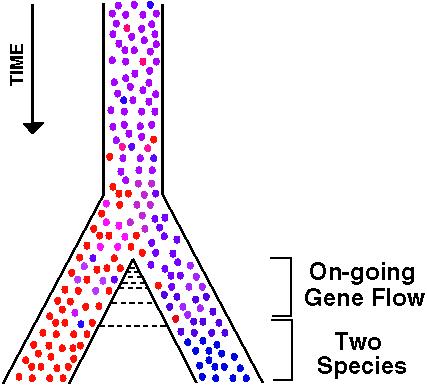
Species Concepts



What are species?
Species concepts and definitions continue to be one of the most controversial topics in biology.
A large number of alternative species concepts exist, each with its own strengths and limitations.
1. The typological species concept: A species is a set of organisms that resemble one another and is distinct from other sets (Linnaeus). But:

Large differences in morphology may be due to single-locus color polymorphisms, as seen in snow geese and king snakes.

Small differences in morphology may be difficult to detect, as with the slight brown coloration on the flank and shorter claw on the hind toe of the short-toed treecreeper.
2. The biological species concept (BSC): "Species are groups of actually or potentially interbreeding natural populations that are reproductively isolated from other such groups" (from Mayr 1942; Dobzhansky 1935). But:

Mallards can hybridize with the northern pintail, but they rarely do so in nature.
3. The evolutionary species concept: A species is a single lineage of populations or organisms that maintains its identity from other such lineages and which has its own evolutionary tendencies and historical fate (Wiley 1978). But:
4. The genealogical species concept: A species is the smallest monophyletic group of common ancestry (de Queiroz and Donoghue 1990). (Meaning: The smallest grouping of organisms for which individuals within the group are more closely related to each other than to any other organism.) But:

5. The ecological species concept: A species is a lineage that occupies an adaptive zone minimally different from that of any other lineage in its range and which evolves separately from all lineages outside its range (Van Valen 1976). But:
And these aren't even all of the species concepts!!
Phenetic species concept, recognition species concept, cohesion species concept, genotypic-cluster species concept, internodal species concept, phylogenetic species concept...
Why is defining "species" such a controversial headache?
For sexual organisms, the evolutionary transition from a single group of interbreeding individuals to two distinct groups of interbreeding individuals will almost always take a substantial period of time, during which it may be difficult determine whether one or two species exist.

Furthermore, hybridization often occurs among recently diverged (and even not so recently diverged) species.

This gene flow may prevent further differentiation of the groups, but it may just slow down the accumulation of differences.
Hybridization and the possibility of limited gene flow is common among closely related species:
1/10000 wild-caught, pregnant females of the species Drosophila pseudoobscura and Drosophila persimilis had mated with the opposite species.
5/2000 fish in a collection of Catostomus catostomus and C. commersoni (sucker fish) were hybrids.

Carrion crows and hooded crows hybridize along a narrow hybrid zone in central Europe.
Oaks frequently hybridize with one another, despite clear and persistent phenotypic differences between the species.

(A): Bear oak, (E) Blackjack oak, (B)-(D) hybrids found in several locations along the Atlantic coast of the US.
In any particular case, it is difficult to know whether current phenotypic differences will be maintained in the face of on-going hybridization or may disappear.
This points to the fundamental problem in identifying species: we do not have a crystal ball and cannot always correctly predict the evolutionary fate of a group of organisms.
It is difficult or perhaps impossible to know whether the factors maintaining differentiation between two closely related groups will continue to act or whether they might, in the future, collapse.



Example of collapsing species boundaries: Cichlid Fish Diversity Threatened by Eutrophication That Curbs Sexual Selection, by Seehausen et al (1997). Science 277: 1808-1811.
Cichlid fishes have undergone dramatic speciation in African rift lakes.
At least 500 species of cichlids evolved in Lake Victoria (the largest of these lakes), utilizing "almost all resources available to freshwater fishes in general, despite having evolved in perhaps as little as 12,400 years and from a single ancestral species."
Many of these species have vanished in recent years, partly due to the introduction of the predatory Nile perch.
However, even those species not eaten by Nile perch have been going extinct.
Cichlids species are isolated from one another by mate choice; cichlids can interbreed and produce fertile offspring but prefer to mate with members of their own species.
Since the 1920's, Lake Victoria has become eutrophic (rich in nutrients due to agricultural run-off and deforestation), leading to increased turbidity of the water.
Seehausen et al (1997) observed:
1. In the lab, mating preferences for individuals of the same species disappeared under monochromatic light.
2. Along a transect in Lake Victoria, an increased brightness in red (Haplochromis nyererei) and in blue (Neochromis "velvet black"/"blue scraper") species in clearer waters.

3. Along a transect in Lake Victoria, an increased number of co-existing species in clearer waters.

 Some cichlid species may have been reproductively isolated from one another before a change in environment (eutrophication of Lake Victoria due to human activities) that led to a breakdown in the ability to distinguish and prefer mates of the same species.
Some cichlid species may have been reproductively isolated from one another before a change in environment (eutrophication of Lake Victoria due to human activities) that led to a breakdown in the ability to distinguish and prefer mates of the same species.
 Loss of species diversity due to breakdown of reproductive isolation rather than extinction.
Loss of species diversity due to breakdown of reproductive isolation rather than extinction.
A clear definition of species is biologically and legally important.
Many species concepts exist, each with its strengths and limitations.
In classifying a group of organisms, gray areas necessarily exist during the early evolutionary diversification of a pair of species.
Although the different species concepts may be equally able to recognise clear-cut species, each makes different decisions in these gray areas.
 SOURCES:
SOURCES: